US Biomedical Sensors Market Size
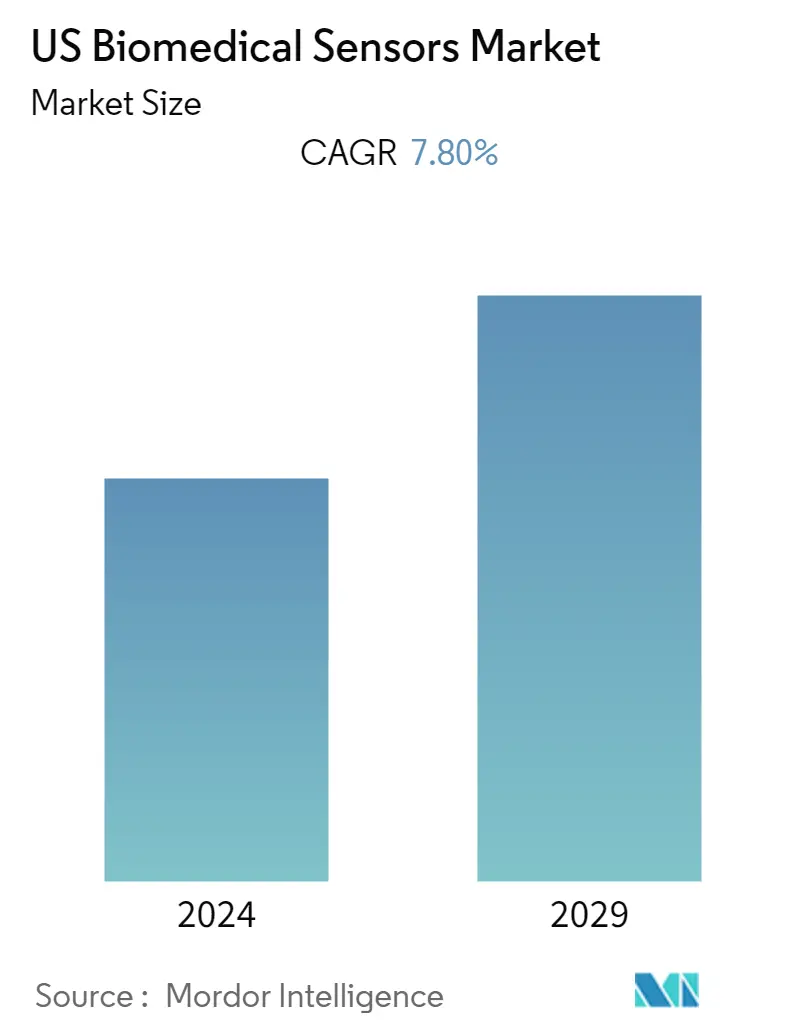
| Study Period | 2019 - 2029 |
| Base Year For Estimation | 2023 |
| Forecast Data Period | 2024 - 2029 |
| Historical Data Period | 2019 - 2022 |
| CAGR | 7.80 % |
| Market Concentration | Low |
Major Players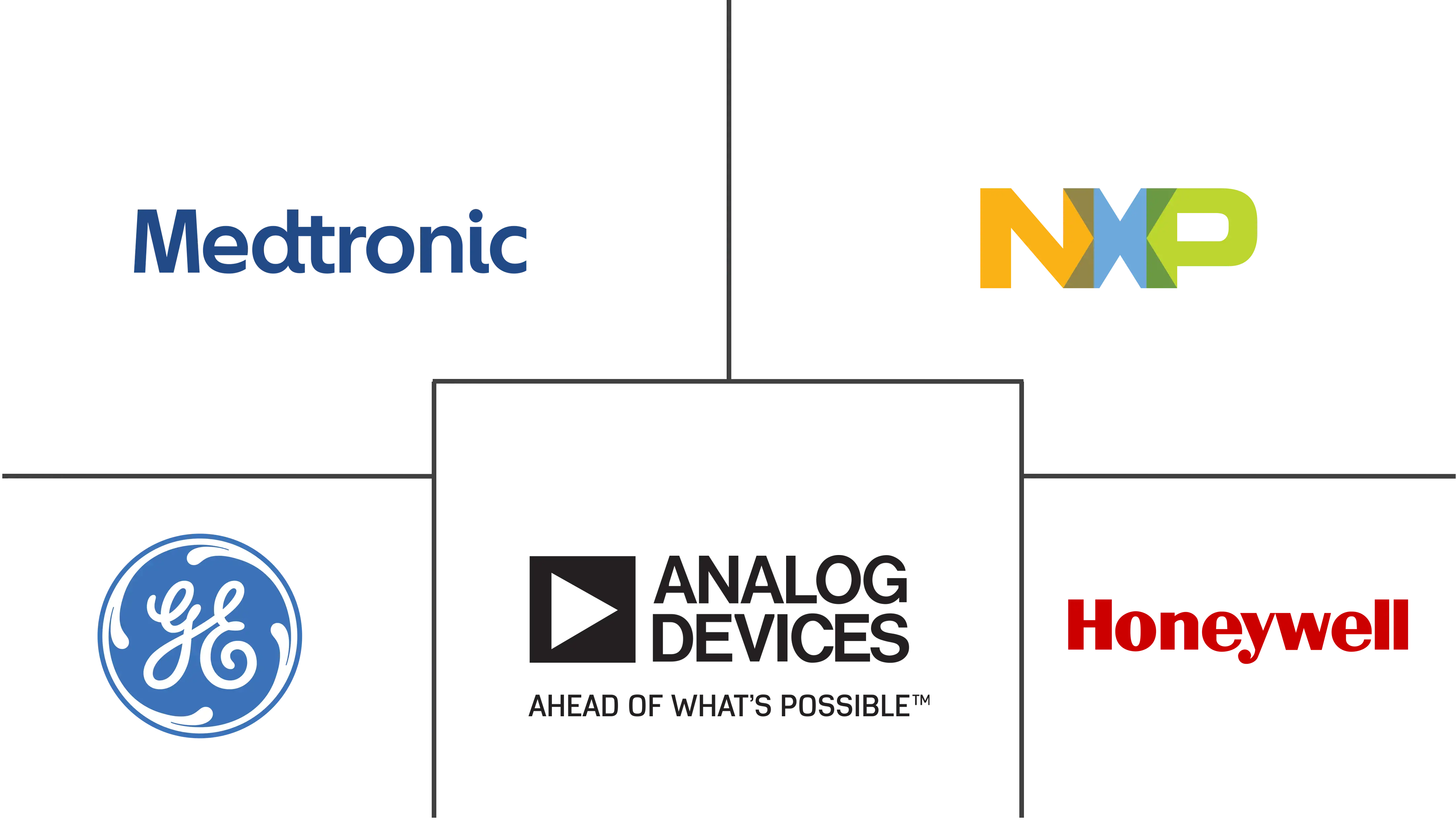
*Disclaimer: Major Players sorted in no particular order |
Need a report that reflects how COVID-19 has impacted this market and its growth?
US Biomedical Sensors Market Analysis
The United States Biomedical Sensors Market is expected to register a compound annual growth rate of 7.8% over the forecast period.
- These sensors can be set to trigger alerts when they enlist unpredictable readings, screen the existence of toxic agents in the blood, or empower drugs directly into the circulatory system. Investments in developing sensors with such capabilities will act as a major factor for the growth of the market, and eventually, these products will find huge demand in the healthcare industry.
- Biomedical sensors are driven by the increased demand in hazardous environments, utilization in situations resulting from natural disasters, increased demand in the healthcare sector for diabetic and heart patients, and embedded monitoring of the patients.
- The advancement in technology has made it possible to build a biomedical sensor using nano and micro technology, making it tiny, robust, smart, and cost-effective. The early detection of irregularities in the health status of the patients will contribute to a better quality of life.
- Even though biomedical sensors are playing a major role in life-saving, they are facing certain challenges such as patient's safety and comfort due to strong electromagnetic fields, transferring energy from external to internal parts with high efficiency and high data rates, limited computation and data storage, and ultra-low power consumption.
- Due to low sales and supply chain disruptions, the impact of COVID-19 has put numerous biomedical sensor firms under strain. It has, however, had a favorable impact on the medical device sector, enhancing R&D activity and, as a result, increasing medical device assistance for COVID-19 detection.
US Biomedical Sensors Market Trends
This section covers the major market trends shaping the US Biomedical Sensors Market according to our research experts:
Growing Demand for fitness devices to Drive the Market Growth
- The incidence and prevalence of lifestyle-related illnesses such as diabetes and hypertension are expected to rise over the projection period as a result of the sedentary lifestyle. Several physiological factors, such as blood sugar levels and blood pressure, must be continuously monitored in some of these disorders. This enables healthcare data integration with portable medical equipment, which may then be provided to clinicians for real-time data access and error reduction. Furthermore, the rising death rate from noncommunicable illnesses is a major source of concern, necessitating a greater focus on tailored monitoring and care. This is expected to boost demand for wearable medical devices and the research industry in the long run.
- The COVID-19 epidemic has increased the importance of wearable medical devices in the healthcare industry. Various firms working on wearable medical products from across the world are joining the market, where wearable medical equipment can detect early warning symptoms of viral infection. The Ava Bracelet, which was originally designed as a fertility tracker, is now being utilized to aid in the fight against the coronavirus. This bracelet monitors heart rate variability, breathing rate, and skin temperature and can be used to follow virus symptoms. This pandemic presents a once-in-a-lifetime opportunity. As a result of this, the demand for wearables is expected to rise.
- The rising frequency of chronic diseases, as well as rising death rates, is a major source of concern for both individuals and government agencies. As a result, healthcare practitioners can provide tailored care that includes ongoing and remote patient monitoring. These can also be worn for up to 24 hours without interfering with daily activities. As a result of the numerous benefits it provides, the demand for wearable medical devices, as well as the studied market, is expected to increase over the projection period.
- Wearable medical devices, on the other hand, present difficulties in allocating cost-effective monitoring to patients and delivering multi-platform capability, both of which are required in developed countries such as Canada and the United States. These factors could stymie wearable technology's expansion in this region. Furthermore, privacy concerns with the transmission of sensitive medical information, as well as the requirement for smaller devices with long battery life, are two of the industry's current challenges.
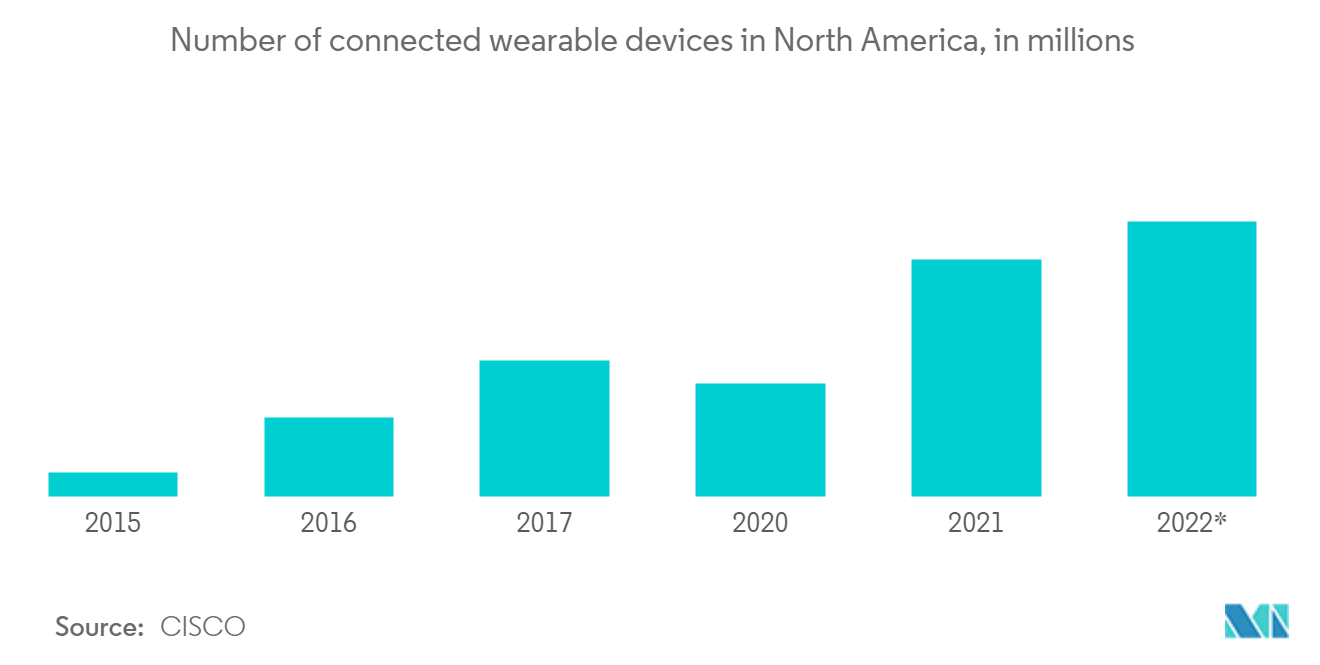
United States to hold Major Share of the Market
- Regular health monitoring employs biomedical sensors. According to the World Health Organization (WHO), about 17.9 million people die each year as a result of cardiovascular illnesses, accounting for 31% of all fatalities globally. The demand for point-of-care monitoring sensors is increasing as the frequency of cardiac arrest, high blood pressure, and strokes rises. Furthermore, governmental groups have created a slew of public awareness campaigns to combat and prevent disease. For example, the Centers for Disease Control and Prevention (CDC) runs the National Heart Disease and Stroke Prevention Program and the Lipid Standardization Program to raise public awareness. These initiatives include trainings and campaigns to raise awareness about the dangers of cholesterol, as well as education for hospital staff. Thus, the rising incidence of lifestyle-based diseases drives the market's growth.
- Since the epidemic, the number of COVID-19 positive cases in North America has increased. As researchers and doctors adjust to working in distant contexts and lab capacity is limited, the clinical and product development engine is facing substantial disruption. Disruptions in both new enrolment and retaining existing patients on medicines have a significant impact on clinical studies. The impact of the COVID-19 outbreak has put a lot of pressure on biomedical sensor firms.
- However, as the demand for R&D activity grows, so does the demand for medical device support for COVID-19 detection, which is driving the medical device sector. For example, researchers at the University of Illinois Grainger College of Engineering developed an ultrasensitive test that detects the presence of the coronavirus in five minutes using a paper-based electrochemical sensor.
- The Canadian government contributed USD 25.8 million in COVID-19 research to help with global attempts to find medical countermeasures against COVID-19. For example, a USD 0.79 million research project titled "Rapid, Ultrasensitive Clinical Detection of 2019 Novel Coronavirus (nCOVID-19) by Novel Microfluidic Electrochemical Nano-Biosensors" was funded. CIHR, the Natural Sciences and Engineering Research Council of Canada (NSERC), the Social Sciences and Humanities Research Council (SSHRC), the International Development Research Centre (IDRC), the Canada Research Coordinating Committee (CRCC) through the New Frontiers in Research Fund (NFRF), and Genome Canada provided USD 26.8 million for COVID-19 research projects during the first wave of the outbreak (GC). As a result, increased government funding for research and development activities is expected to support the expansion of the biomedical sensors market.
- Home fitness surged explosively among active Americans and gym members, according to RunRepeat's Fitness Trends 2021 report: In 2021, active Americans saw huge growth in both at-home fitness equipment (up 218.3%) and online fitness (up 134.7%) as the best approach to meet fitness goals. Gym members also cited at-home workout equipment (115.9%) and internet fitness (93.3%) as the greatest ways to stay active. These factors project a strong growth of studied market in the region.
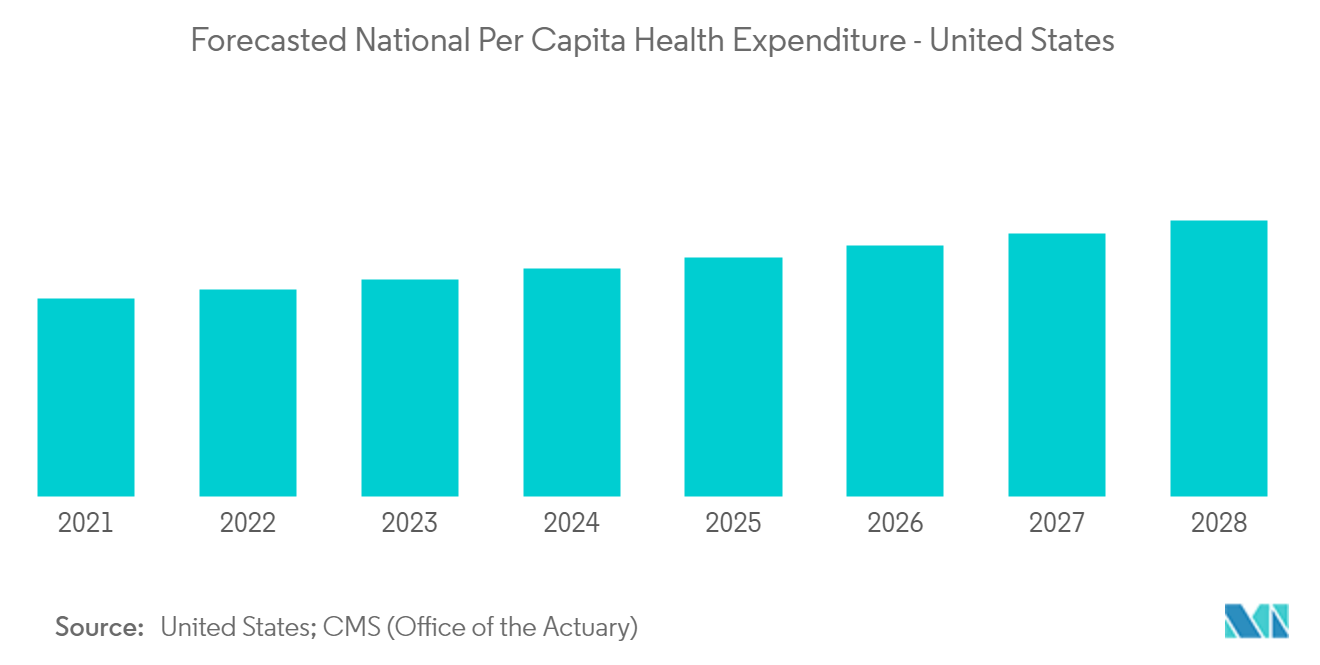
US Biomedical Sensors Industry Overview
The market is highly competitive with the presence of various players in the market that provide various types of sensors. Moreover, these sensors are continuously getting advanced as companies invest significantly in improving the capabilities and characteristics of these sensors. Additionally, the market players are also focusing on partnerships and collaborations with new product developments, among others, to increase their profitability and improve their share in the market.
- In January 2022, The use of electronic textile sensors to provide and decode important bodily data has been researched. The digitization of textiles (textronics) has opened up new possibilities for combining conformable sensors with noninvasive, continuous decoding of important bodily signals. It examines the present performance characterization approaches for these sensors and emphasizes the necessity for standardized test methods in the areas of biocompatibility, thermal and tactile comfort, aging, and biomedical sensing modality operating at a standard human stretch.
- In February 2022, New gold and platinum formulations have been added to Electroninks' line of particle-free conductive inks. Consumer electronics, medical gadgets, sensors, and semiconductors can now use gold and platinum inks to create lighter, less expensive, and more ecologically friendly goods. Metal-organic precursors in the novel gold and platinum metal inks break down cleanly at lower temperatures than nanoparticle inks and can be UV-cured.
US Biomedical Sensors Market Leaders
-
NXP Semiconductors
-
General Electric Company
-
Honeywell International Inc.
-
Analog devices, Inc.
-
Mediatronic
*Disclaimer: Major Players sorted in no particular order
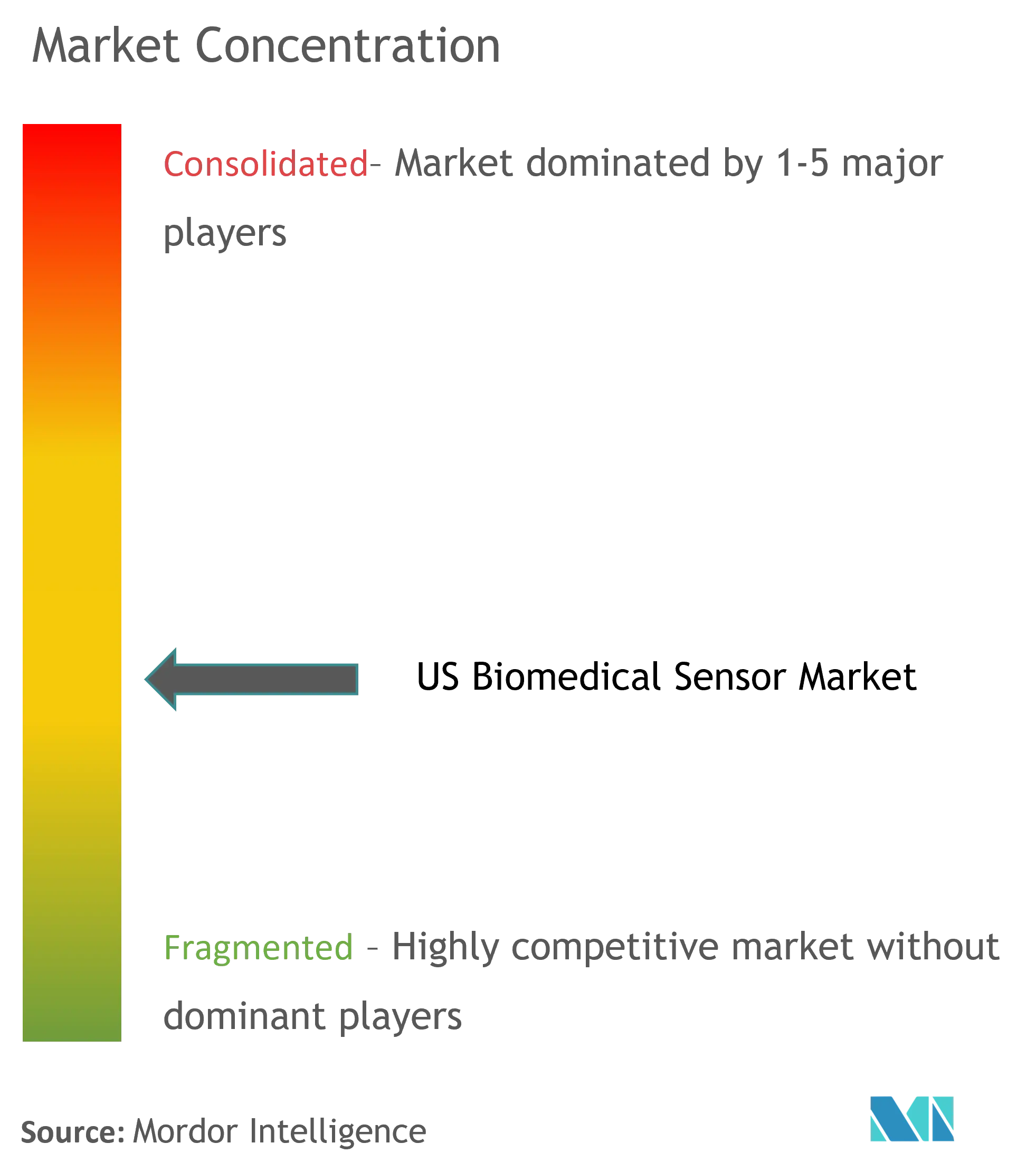
US Biomedical Sensors Market News
- In February 2021, Biomedical engineers at Missouri and S&T were developing 'smart' sensor bandages. Many people are turning to virtual doctor meetings and consultations as a safer alternative to in-person doctor visits in the face of COVID-19 limitations and limited travel. Researchers at Missouri S&T are aiming to improve the success of this new wave of telemedicine by developing an oxygen-sensing patch that can communicate with a smartphone and is printed on a flexible, disposable bandage. This smart bandage could allow for remote monitoring of ailments like pressure ulcers, enabling quick treatment or intervention.
- In January 2021, PressureDOT, Taiwan, developed one of the smallest wireless intra-abdominal pressure sensing capsules, designed to be used in critical care to prevent unnecessary laparotomies and organ failure in patients with traumatic abdomen injuries pancreatitis, and septicemia. The capsule comprises a pressure sensor and a Printed Circuit Board Assembly (PCBA) that can pass into the body via swallowing or nasogastric tube delivery.
US Biomedical Sensors Market Report - Table of Contents
1. INTRODUCTION
- 1.1 Study Assumptions and Market Definition
- 1.2 Scope of the Study
2. RESEARCH METHODOLOGY
3. EXECUTIVE SUMMARY
4. MARKET DYNAMICS
- 4.1 Market Overview
-
4.2 Market Drivers
- 4.2.1 Growing Demand for fitness devices
- 4.2.2 Increasing Spending on Diagnostics
-
4.3 Market Restraints
- 4.3.1 High Costs of the Systems
- 4.4 Value Chain / Supply Chain Analysis
-
4.5 Industry Attractiveness - Porter's Five Forces Analysis
- 4.5.1 Threat of New Entrants
- 4.5.2 Bargaining Power of Buyers
- 4.5.3 Bargaining Power of Suppliers
- 4.5.4 Threat of Substitute Products
- 4.5.5 Intensity of Competitive Rivalry
- 4.6 Assessment of the Impact of COVID-19 on the Market
5. MARKET SEGMENTATION
-
5.1 Type
- 5.1.1 Wired
- 5.1.2 Wireless
-
5.2 Sensor Type
- 5.2.1 Temperature
- 5.2.2 Pressure
- 5.2.3 Image Sensors
- 5.2.4 Biochemical
- 5.2.5 Inertial Sensors
- 5.2.6 Motion Sensors
- 5.2.7 Electrocardiogram (ECG)
-
5.3 Industry
- 5.3.1 Pharmaceutical
- 5.3.2 Healthcare
6. COMPETITIVE LANDSCAPE
-
6.1 Company Profiles
- 6.1.1 NXP Semiconductors
- 6.1.2 Medtronic
- 6.1.3 GE Healthcare
- 6.1.4 Honeywell International inc
- 6.1.5 STMicroelectronics N.V.
- 6.1.6 Smiths Medical
- 6.1.7 Analog Devices, Inc.
- 6.1.8 TE Connectivity
- 6.1.9 Pinnacle Technology, Inc.
- 6.1.10 Sensirion AG
- 6.1.11 RESONETICS
- *List Not Exhaustive
7. Investment Analysis
8. Future of the Market
** Subject To AvailablityUS Biomedical Sensors Industry Segmentation
Biomedical sensors are electronic devices that can transduce biomedical signals into measurable electric signals. Biomedical sensors are the critical component in various medical diagnostic instruments and equipment. These sensors can come in wired or wireless forms. Moreover, various types of sensors are available today, including temperate sensors, pressure sensors, biochemical sensors, image sensors, motion sensors, Electrocardiogram (ECG), among others.
The United States Biomedical Sensors Market is segmented By Type (Wired, Wireless), Sensor Type (Temperature, Pressure, Image sensor, Biochemical, Motion Sensor, Electrocardiogram), Industry (Pharmaceutical, Healthcare), Application (Diagnostics, Therapeutics, Medical Imaging, Monitoring, Fitness, and Wellness), Geography.
| Type | Wired |
| Wireless | |
| Sensor Type | Temperature |
| Pressure | |
| Image Sensors | |
| Biochemical | |
| Inertial Sensors | |
| Motion Sensors | |
| Electrocardiogram (ECG) | |
| Industry | Pharmaceutical |
| Healthcare |
US Biomedical Sensors Market Research FAQs
What is the current US Biomedical Sensors Market size?
The US Biomedical Sensors Market is projected to register a CAGR of 7.80% during the forecast period (2024-2029)
Who are the key players in US Biomedical Sensors Market?
NXP Semiconductors, General Electric Company, Honeywell International Inc., Analog devices, Inc. and Mediatronic are the major companies operating in the US Biomedical Sensors Market.
What years does this US Biomedical Sensors Market cover?
The report covers the US Biomedical Sensors Market historical market size for years: 2019, 2020, 2021, 2022 and 2023. The report also forecasts the US Biomedical Sensors Market size for years: 2024, 2025, 2026, 2027, 2028 and 2029.
US Biomedical Sensors Industry Report
Statistics for the 2024 US Biomedical Sensors market share, size and revenue growth rate, created by Mordor Intelligence™ Industry Reports. US Biomedical Sensors analysis includes a market forecast outlook to 2029 and historical overview. Get a sample of this industry analysis as a free report PDF download.

